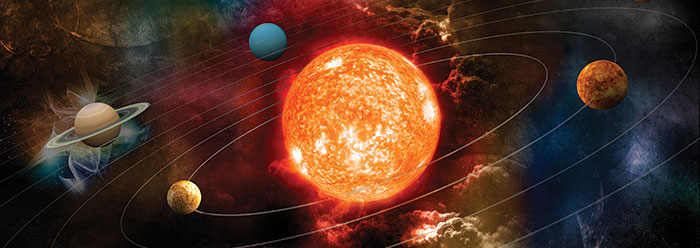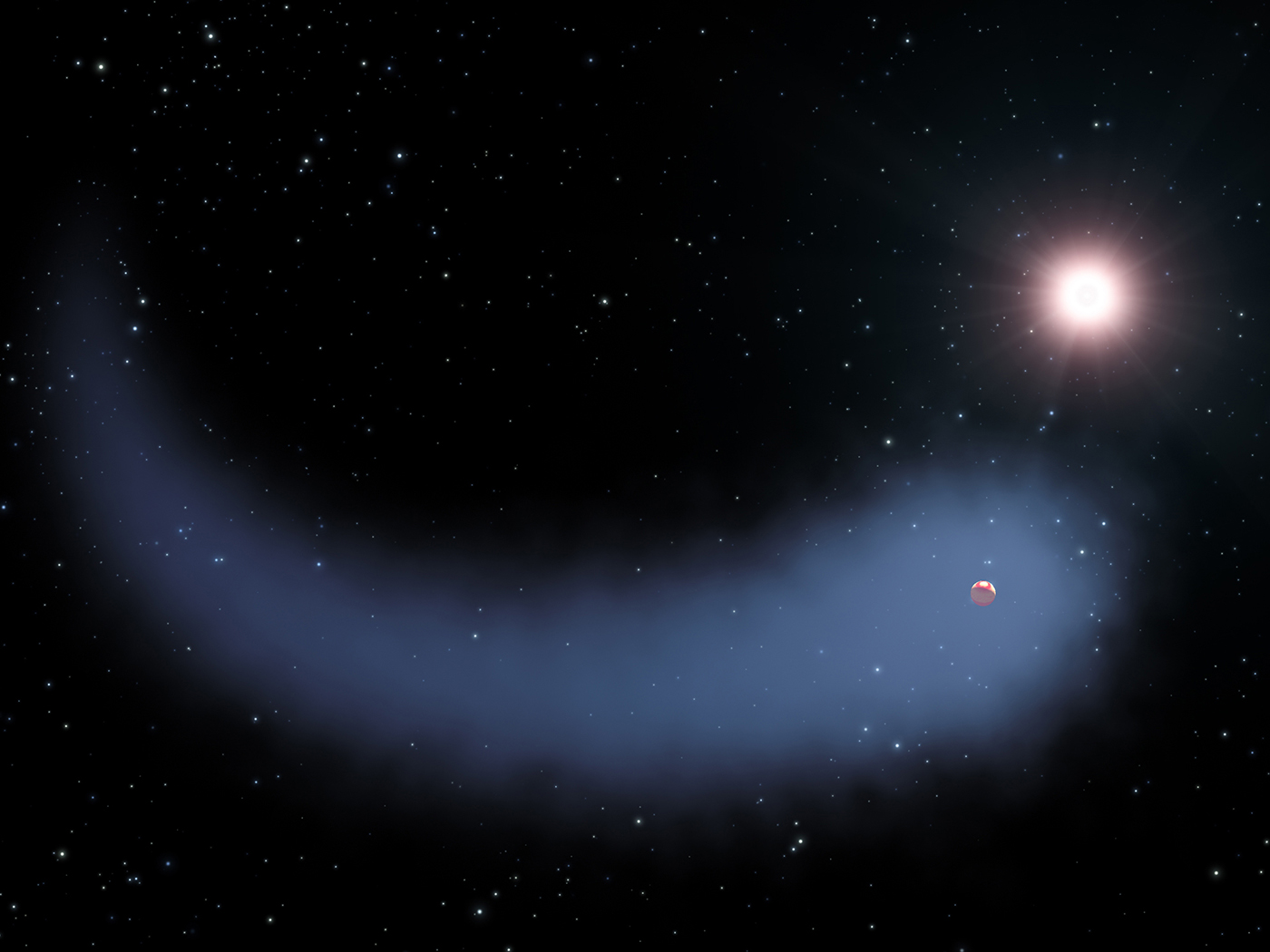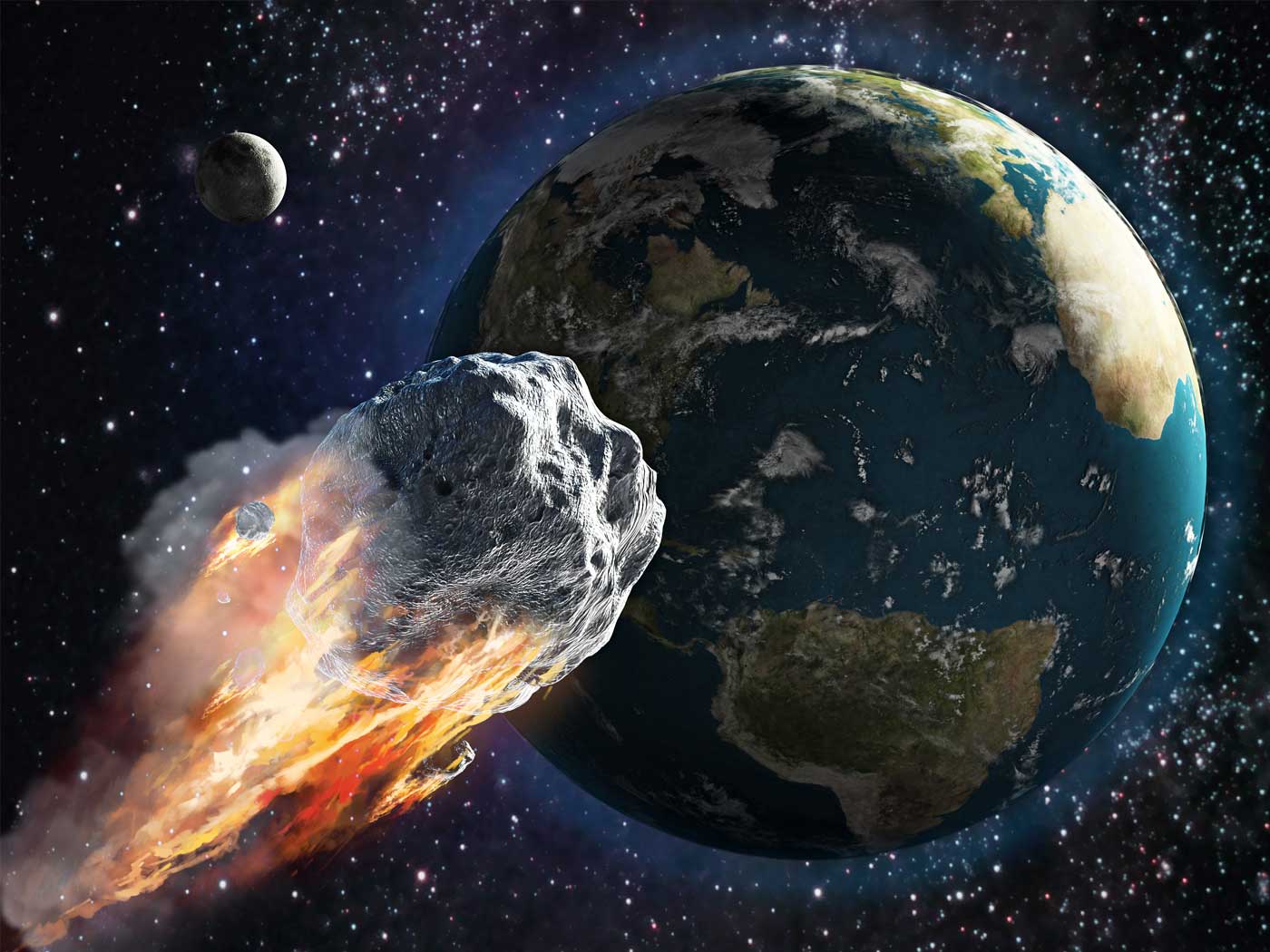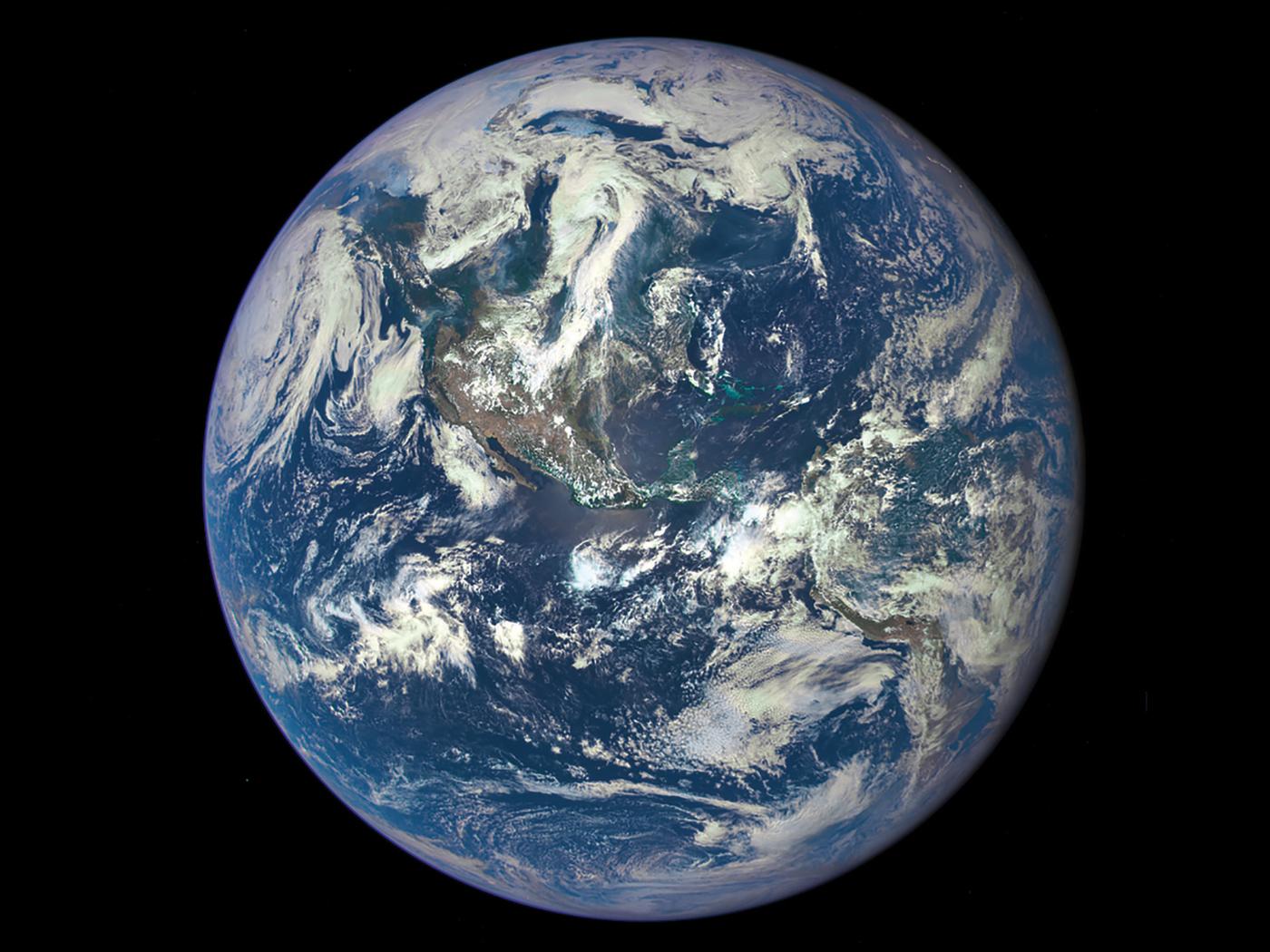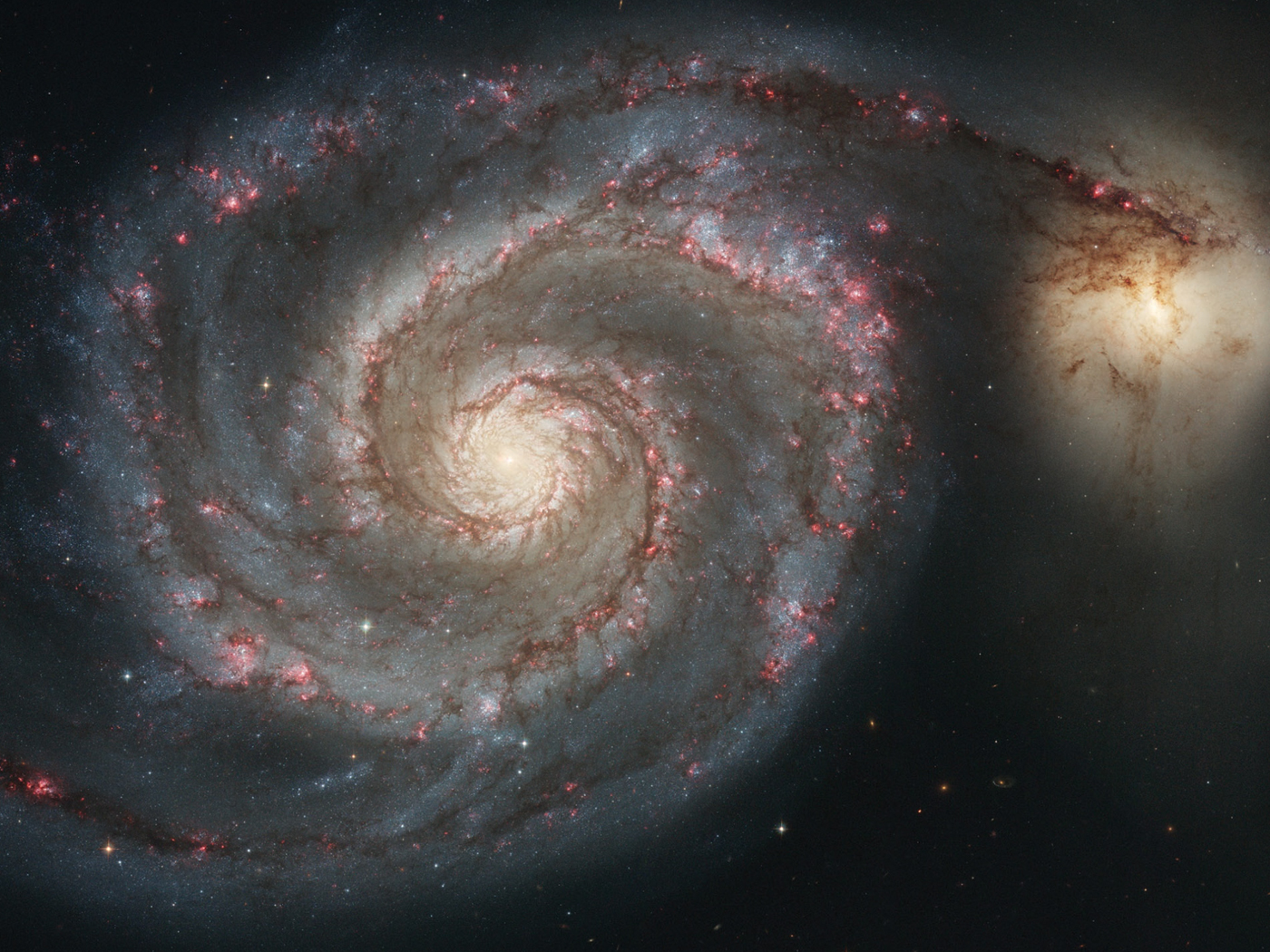One of the wonderful things about astronomy is that it is so different from our everyday experience. Things are not what they might seem at first glance. Who could have guessed that those tiny little specks of light in our night sky are actually “suns” hundreds of times larger than Earth? Who would have suspected that the “evening star” is actually a rocky planet about the same size as our own? How unexpected to find that the solid earth beneath our feet is actually moving at 67,000 miles per hour around the sun, all the while spinning like a top! God has constructed the universe in a truly marvelous way. As we study it, the universe continually surprises and delights us by challenging our understanding of how things work.
Our solar system is a great example of this. We can actually see much of the solar system on a cloudless night. Most of the planets are visible to the unaided eye—appearing as tiny points of light. In reality, they are enormous spheres, some comparable in size to the earth, while others are much larger. The sun and moon are visible as small circles in our sky. Yet, in reality the moon is as large in diameter as the continental United States, and the sun is 400 times wider than the moon. The stars, sun, moon, and planets rise and set with clockwork precision. They seem to pay tribute to the earth as they respectfully circle around their master. But the truth of the matter is that Earth rotates as it moves around the sun. Every new discovery in astronomy is a surprising and delightful revelation that God is even more amazing, creative, and powerful than we previously supposed.
The solar system consists of the sun and everything that orbits the sun. Orbiting bodies include the eight planets, asteroids, comets, centaurs,1 trans-Neptunian objects, and dust. The largest and most massive object in the solar system is the sun itself. It is a sphere of hydrogen and helium gas, held together by its own gravity. With a diameter of 865,000 miles, the sun is 110 times wider than Earth. It constitutes 99.8 percent of all the mass in the solar system. Yet, from our view on Earth, we can easily cover the sun with one finger held at arm’s length.2 The sun only appears so small in our sky because it lies at an amazing distance away from us—93 million miles. A car travelling at 60 miles per hour would take 176 years to travel such a distance. It boggles the mind.
The Planets
The next largest objects in the solar system are the planets. Jupiter is the largest planet, with a diameter of 86,881 miles, or about 11 times the diameter of Earth. Saturn is the next largest, followed by Uranus, Neptune, Earth, Venus, Mars, and Mercury. Older textbooks list Pluto as the smallest planet, but most astronomers now classify Pluto as a “dwarf planet” or trans-Neptunian object, leaving Mercury with the title of “smallest planet.” All eight planets orbit the sun in the same direction (counterclockwise as viewed from Earth’s north pole) and are very nearly in the same plane. This plane is called the ecliptic.
The four planets nearest the sun are called terrestrial (“earthlike”). They are relatively small worlds with dense, rocky compositions. In order of increasing distance from the sun they are Mercury, Venus, Earth, and Mars. The remaining four planets are called gas giants or Jovians (“like Jupiter”). They are much larger than terrestrials, but are comprised primarily of hydrogen and helium gas rather than dense materials like rock. As with the sun, these balls of gas are held together by their own gravity. As we move away from the sun, the gas giants are Jupiter, Saturn, Uranus, and Neptune. The outer two planets, Uranus and Neptune, are smaller than Jupiter and Saturn and are sometimes called ice giants instead of gas giants due to their high abundance of various forms of ice.3
Solar System Distances
Distances in the solar system are often listed in terms of astronomical units (AU). We define 1 AU as the average distance between the earth and the sun, which is about 93 million miles. Astronomical units are much more convenient for conveying distances within the solar system than miles or kilometers, which can become unwieldy to contemplate on such vast scales. Mercury is only 0.39 AU from the sun, whereas the distance of Venus is 0.72 AU. The orbit of Mars averages 1.52 AU from the sun. So, the terrestrial worlds are all within 3 AU of each other at all times. But the gas giants orbit considerably farther out. Jupiter orbits at 5.2 AU, and Saturn is 9.54 AU—putting it at around 1 billion miles from the sun! Uranus is 19.1 AU from the sun, and Neptune lies at a distance of 30 AU—almost 3 billion miles—30 times farther from the sun than Earth.
The distance between the planets is astonishing and difficult to visualize. Most textbook illustrations of the solar system enlarge the planets by enormous factors in order for them to be visible along with their orbits (like the illustration in this article). In reality, the planets are dwarfed by their distances from the sun. The University of Colorado has a scale model of the solar system, with the sun represented by a 5.5-inch sphere on a pedestal placed just outside Fiske Planetarium. The earth is located on a pedestal 50 feet away. The planet itself is shown at the same scale as a tiny “bump” about 1/20 of an inch. Mercury, Venus, and Mars are just a few feet away. But Jupiter is considerably farther out and is the size of a marble. To get to Neptune, a person must walk all the way to the other side of campus, a stroll of about 10 minutes. The orbits of the outer planets have considerably more space between them than the orbits of the inner planets.
Planetary Orbits
The orbits of all the planets are nearly circular. Creation scientist Johannes Kepler, in the 17th century, discovered the true shape of these orbits. He analyzed data from the orbit of Mars that had been obtained by Tycho Brahe. Kepler discovered that planets orbit in ellipses—“squashed” circles. A circle is defined as the set of all points in a plane equidistant from a given point. An ellipse is the set of all points in a plane whose distance from two fixed points gives the same sum. The two points are called “foci” (plural); each one is a “focus” (singular). Kepler also found that the sun was located exactly at one focus (the other focus is empty). The fact that planets orbit in ellipses with the sun at one focus is referred to as Kepler’s first law of planetary motion. Kepler did not know why orbits were like this, nor did anyone else until the time of Isaac Newton. For the planets, the two foci are relatively close to each other, making the resulting ellipse almost indistinguishable from a circle. But for a comet, the ellipse can be very elongated.
Johannes Kepler also discovered that any given planet “sweeps equal areas in equal times.” In other words, planets speed up when they are closer to the sun and slow down when farther away. This is Kepler’s second law of planetary motion. Kepler further found a relationship between the size of a planet’s orbit and the time it takes the planet to go around the sun once. Specifically, the square of the period of the orbit (in years) is equal to the cube of the planet’s average distance from the sun in AU. In other words, planets that orbit close to the sun have short periods, whereas those that orbit far away from the sun have very long periods. For example, Mercury has a distance of 0.39 AU and orbits the sun in only 88 days (0.24 years). Neptune has a distance of 30 AU and a period of just under 165 years. In both cases, the square of the period is equal to the cube of the distance. Kepler didn’t know why this rule worked. It was a mystery until Newton came on the scene.
Although Kepler’s laws were discovered in relation to planets, they work equally well for asteroids, centaurs, trans-Neptunian objects, and comets.4 These laws also apply to orbits of moons.5 It was another creation scientist who discovered the principles behind Kepler’s laws. Isaac Newton, a brilliant scientist and Bible scholar, discovered and rigorously proved that gravity is the cause of the orbital motions of planets. The closer a planet is to the sun, the faster it orbits because the sun’s gravity is stronger. Newton’s discoveries of the laws of motion and gravity allowed him to mathematically prove all three of Kepler’s laws from first principles. He also modified Kepler’s third law to include the effects of different masses on the constant of proportionality, allowing us to use Newton’s version of Kepler’s third law for moons or for other solar systems with stars of different masses.
The Laws of the Universe
Bible critics sometimes view laws of nature as a replacement for God’s power. But that certainly is not a biblical view. The Bible teaches that God directly controls the universe—that by the expression of His power everything is upheld (Hebrews 1:3). God is not a god of confusion (1 Corinthians 14:33), but upholds the universe in a consistent and often predictable way. Laws of nature are not a substitute for God’s power; rather, they are examples of it. God’s consistent and law-like sovereignty over the universe makes astronomy possible.
The solar system is a lesson in humility. When we contemplate the sizes of these worlds, the distances involved, and the God who holds every atom in its place, it is amazing to think such a God would show so much compassion and mercy toward us. “When I consider Your heavens, the work of Your fingers, The moon and the stars, which You have ordained, What is man that You are mindful of him, And the son of man that You visit him?” (Psalm 8:3-4).
References
- Centaurs are minor planets that orbit primarily in between Jupiter and Neptune and possess characteristics of both asteroids and comets.
- It is not safe to look directly at the sun without specialized equipment. Viewing the sun without such equipment can cause permanent damage to the eye.
- In astronomy, “ice” refers to any solid that would be gas or liquid under conditions on Earth. The ice found in the solar system can include water-ice (H2O), as well as methane (CH4), carbon dioxide (CO2), and ammonia (NH3).
- For some comets, Kepler’s first law takes on a modified form. An ellipse is merely one of three possible conic sections (the different types of curves that can be obtained by intersecting a cone with a plane), the other two being a parabola and a hyperbola. Some comets have a parabolic or slightly hyperbolic trajectory rather than a closed ellipse. But the sun remains at the focus, and Kepler’s second law remains unchanged.
- The constant of proportionality in Kepler’s third law is different for orbits of moons than it is for orbits of planets. This constant is determined by the mass of the system, and planets have a different mass than the sun. But the proportionality continues to hold; the square of the period is proportional to the cube of the average distance.
* Dr. Lisle is Director of Physical Sciences at the Institute for Creation Research and received his Ph.D. in Astrophysics from the University of Colorado.
Cite this article: Lisle, J. 2013. The Solar System. Acts & Facts. 42 (6): 10-12.




